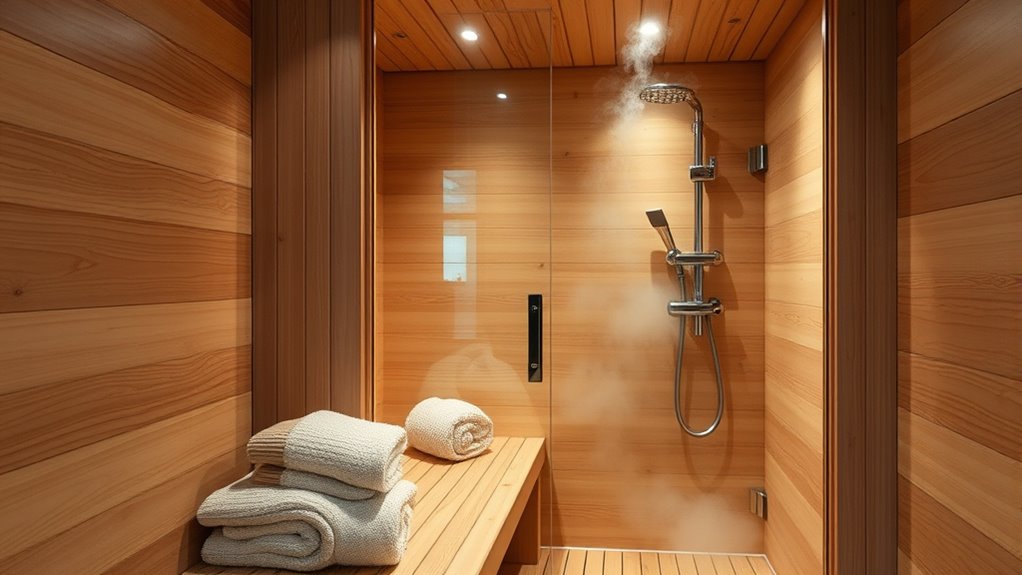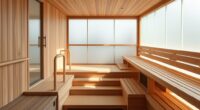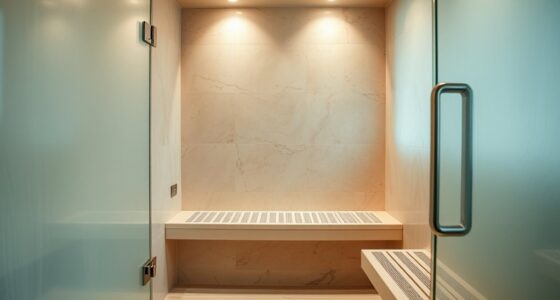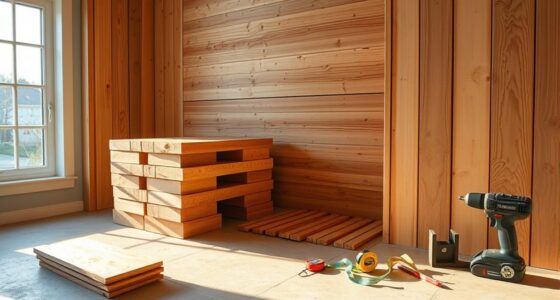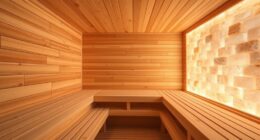To build a combined sauna and shower unit, focus on proper insulation with moisture-resistant materials like mineral wool or foam board, and seal all joints with waterproof tape to retain heat. Make certain good ventilation by adding an exhaust fan and fresh air intake to control humidity and prevent mold. Position vents for natural airflow, especially near exterior walls. Taking these steps helps create a comfortable, durable space—if you keep going, you’ll discover how to get it just right.
Key Takeaways
- Use moisture-resistant insulation materials like mineral wool or foam board to prevent damage from high humidity.
- Design effective ventilation with exhaust fans and fresh air vents to control moisture and maintain air quality.
- Seal all joints and gaps with waterproof sealant or foil tape to improve heat retention and prevent leaks.
- Position the unit near an exterior wall for natural cross-ventilation and easier integration of ventilation systems.
- Ensure electrical components and ducts are rated for wet environments, following safety standards for durability and safety.
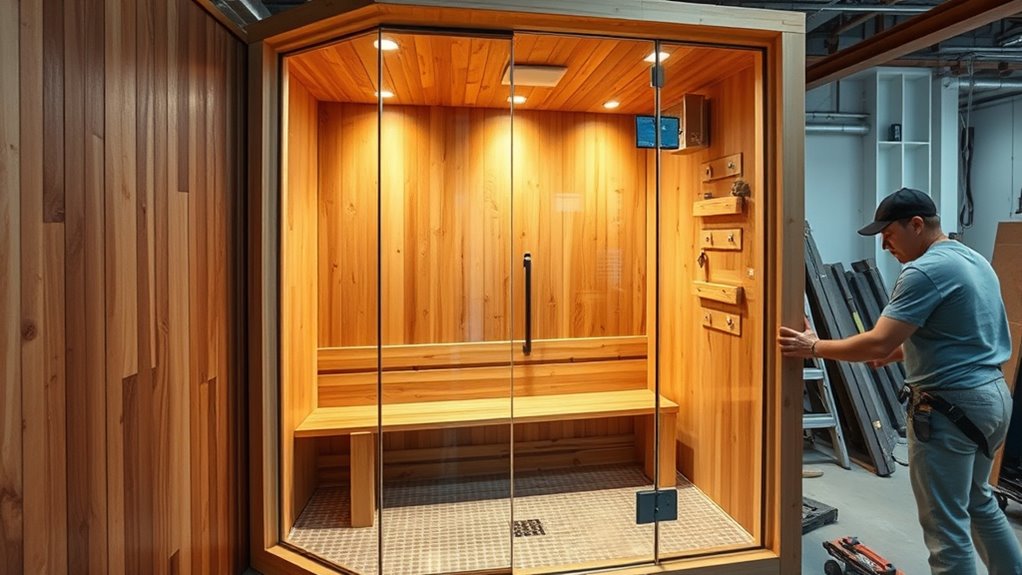
Creating a combined sauna and shower unit can be a practical way to maximize space and enhance your home wellness area. To guarantee the unit functions efficiently and remains comfortable, paying attention to insulation techniques and ventilation strategies is essential. Proper insulation keeps the heat in during sauna use and prevents moisture from damaging surrounding areas, while effective ventilation removes excess humidity and maintains air quality. Incorporating soundproofing techniques can also help reduce noise transfer, creating a more peaceful environment inside and outside the unit.
Maximize your wellness space with proper insulation and ventilation for a comfortable, efficient sauna and shower combo.
When planning your sauna and shower combo, start with insulation. Use high-quality, moisture-resistant materials such as mineral wool or foam board insulation designed for wet environments. These materials help retain heat inside the sauna, reducing energy costs and creating a consistent, relaxing temperature. Seal all joints and gaps thoroughly with waterproof sealant or foil tape to prevent heat loss and moisture infiltration. Proper insulation not only improves energy efficiency but also protects your walls and ceiling from mold and decay caused by high humidity.
Ventilation strategies are equally critical. A well-designed ventilation system controls humidity levels, preventing condensation that can lead to mold growth and structural damage. Installing an exhaust fan near the shower area helps expel moist air quickly, while a fresh air intake vent ensures a steady flow of dry, oxygen-rich air. Consider incorporating a humidity sensor that automatically activates the exhaust fan when moisture levels rise above a certain point. This automation maintains a comfortable environment without requiring constant manual adjustment.
In addition to mechanical ventilation, natural airflow can complement your system. If possible, position your unit near an exterior wall to facilitate cross-ventilation. Use vent covers that can be adjusted to regulate airflow, especially in colder months when you want to minimize heat loss. Adequate ventilation also ensures that unpleasant odors and excess moisture don’t linger, making your wellness space more inviting.
Installation of the ventilation components should be done with care. Ducts and vents must be airtight to maximize efficiency, and all electrical components should meet safety standards for wet environments. Insulation and ventilation go hand-in-hand; properly insulated walls prevent heat from escaping, while strategic ventilation ensures moisture doesn’t build up inside those insulated spaces.
Frequently Asked Questions
What Are the Best Materials for Waterproofing the Unit?
You should use waterproofing membranes like rubber or PVC for the best protection, as they’re durable and reliable. Sealant options such as silicone or polyurethane work well for sealing joints and edges, preventing leaks. Applying these materials carefully guarantees your sauna and shower unit remains watertight. Make sure to follow manufacturer instructions for proper installation, and consider combining membranes with sealants for ideal waterproofing and long-lasting performance.
How Do I Ensure Proper Ventilation?
Proper ventilation is like a revitalizing gust in a busy room; it keeps your space comfortable. To guarantee this, install an exhaust fan and maintain good air circulation. Use vents to control humidity and prevent mold. Regularly open doors or windows after use to promote air flow. Proper humidity control and continuous air circulation are key to avoiding moisture buildup, keeping your sauna and shower unit fresh and healthy.
What Safety Features Should Be Included?
You should include safety features like proper electrical safety measures, such as waterproof outlets and grounding, to prevent shocks. Install smoke and carbon monoxide detectors for fire prevention, and keep a fire extinguisher nearby. Use heat-resistant materials and make certain all wiring complies with safety standards. Also, add easily accessible emergency shut-off switches. These steps help protect you from electrical hazards and reduce fire risks, making your sauna and shower unit safer to enjoy.
How Much Does It Typically Cost to Build?
The cost to build a combined sauna and shower unit varies based on size, materials, and features, but typically ranges from $3,000 to $10,000. You should consider cost considerations like insulation, heating options, and waterproofing. Budget planning helps you prioritize features and materials to stay within your financial limits. By comparing prices and selecting quality, affordable options, you guarantee your project is both functional and cost-effective.
Can I Customize the Size and Layout?
Think of your sauna and shower as a tailor-made suit; you can customize the size and layout to fit you perfectly. With modular design, you’re the designer, adjusting dimensions and features for ideal space utilization. This flexibility allows you to create a cozy retreat or a spacious spa, all while maximizing space optimization. So, yes, you can personalize your unit to match your needs and style.
Conclusion
Now that you’ve built your combined sauna and shower unit, you can relax in a cozy steam sanctuary after a long day. Imagine the warm steam swirling around you, like a scene straight out of a Victorian painting, as the modern convenience of your creation transports you to a simpler, more indulgent time. With a little effort, you’ve crafted a space that offers both relaxation and refreshment—your personal retreat, timeless and inviting.
